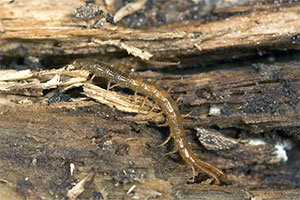|
Collecting

Many interesting animals can be found in rotting logs on the ground. During the day, invertebrates find refuge in damp, secluded places – under logs and stones in the forests, among leaf litter, under bricks, paving tiles, pieces of wood, in garden compost, and in other similar situations. At night many soil animals can be seen in the open – on the rocks along forest stream beds or on the surface of moist soil.
The simplest way to find larger soil invertebrates – slugs, snails, flatworms, millipedes, is to look for them in the field directly. When looking for invertebrates, always place overturned logs and stones back into their original position - it will preserve the habitat for many species. Pitfall traps provide a good way to catch active surface runners. For many minute groups, aspirators and Berlese extractors are excellent.
Collecting in New Zealand
I advise not to collect soil and litter invertebrates, unless as a part of scientific research. It is much more rewarding to observe or photograph live animals as they are, without killing and preserving them. Most of the New Zealand land invertebrates are active and colourful when live, and loose all colours in storage. For most groups, identification to a species level is difficult, and requires examination of fine structures under a microscope. Many endemic species are rare, have very localized distribution, and may be damaged by over-collection. See Collection Code for New Zealand Invertebrates for more advice on collecting.
Permits from the New Zealand Department of Conservation are required for any collecting in National Parks, Scenic Reserves, State Forests, and any other land managed by DOC. Permits from land owners need to be obtained if collecting on private land. The endangered species (for example, giant land snails) are protected at the national level, and should not be collected or disturbed anywhere in New Zealand. See Conservation Requirements of NZ's Nationally Threatened Invertebrates.
Maintaining records
Without accurate record keeping and labelling, a specimen has no scientific value for museums or other researchers - labels provide vital information on species distribution and habitat. If photographing or collecting invertebrates, always record the locality, date, the name of the collector (photographer), and the exact circumstances in which each specimen was found. The same rule applies if the animal is preserved for future storage - it is essential to provide a detailed label (in pencil is best) in the storage container together with the specimen.
Existing Research Collections in New Zealand
The existing research collections are an important source of study material for governmental and university researchers in New Zealand and worldwide. There are two major research collections in New Zealand that hold land invertebrates. The collections contain the primary types of species described in the New Zealand region (the type is the specimen on which a published description of a species is based), as well as voucher specimens (positively identified example of a species) for many native invertebrate species, as well as species introduced or intercepted in New Zealand. The collections also contain large quantities of specimens from the Pacific Islands, and some materials from other parts of the world.
The New Zealand Arthropod Collection (NZAC), which is a part of Landcare Research, is located in Auckland. It is the largest collection of terrestrial invertebrates in New Zealand, with more than 6.5 million specimens and ~ 2600 primary types. The NZAC focuses on insects and mites, but other groups of terrestrial arthropods are also represented. The Landcare Research staff at NZAC provide information and identification services to scientists as well as the general public, on request. Depending on the time involved, there may be a charge for consultations or for the identification of specimens. If you would like to send live invertebrates for identification, learn How to Send Live Invertebrates through the Post. Click here to access the entire NZAC website.
The Invertebrate Collection at Te Papa Tongarewa Museum of Wellington is the second largest in New Zealand, and serves as a source of specimens for Te Papa's displays, as an excellent educational resource for the public, and as a research resource for scientists. The Te Papa collection of invertebrates includes about 600 000 specimens and ~ 1100 primary types; it is particularly strong in insects, springtails, spiders, harvestmen, tardigrades, and molluscs. The staff of the Te Papa collection can be addressed with scientific inquiries. Click here to access the website of the Te Papa invertebrate collection.
Donating a specimen to a NZ research collection
If you would like to donate an invertebrate specimen to the NZAC or to the Te Papa collection, first make sure that the specimen is in good condition, that the labelling is full and accurate, and that the specimen was not collected unlawfully. If accepted, your specimen will become a part of New Zealand national heritage, and will receive the highest standards of professional care in preservation and maintenance.
Next, contact the collection curator. To contact a curator of Te Papa collection, you can call the Te Papa Enquiry Centre, Tel. (04) 381 7000. For more information about making a gift or donation to Te Papa please read Te Papa - Making a Donation or Bequest. For the New Zealand Arthropod Collection, the enquiries can be directed to
Landcare Research, Private Bag 92170, Auckland, Tel. (09) 574 4100.
Back to Home
|